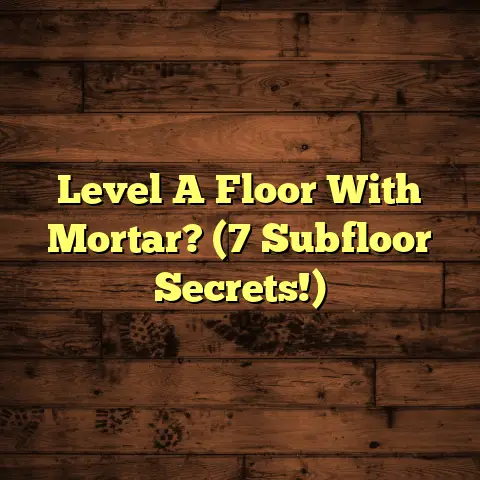Common Hardwood Floor Widths? (3 Sizes to Know!)
A lot of that magic comes down to the width of the hardwood planks.
As a flooring contractor for over 15 years, I’ve seen it all.
And trust me, the width you choose can totally transform a space.
Let’s dive into how hardwood flooring can not only be functional.
But also an essential element of comfort, aesthetics, and durability.
Imagine this: It’s a typical Saturday morning at the Johnson’s.
Kids are running around, the dog’s chasing a rogue tennis ball.
And Mom and Dad are trying to prep for a family barbecue.
Their hardwood floors? They’re not just a surface; they’re the stage.
They handle the chaos, the spills, and the constant foot traffic.
All while adding warmth and character to their home.
The right flooring choice enhances the living space and contributes to the overall décor.
It withstands the rigors of daily life.
And in today’s world, where open floor plans are all the rage.
Your flooring choice impacts the perception of space and light.
So, ready to geek out about hardwood widths with me? Let’s go!
Overview of Hardwood Flooring
Okay, so what is hardwood flooring?
Simply put, it’s flooring made from
a single piece of hardwood.
Think oak, maple, walnut, or cherry.
I’ve installed it in everything from cozy apartments to sprawling offices.
The benefits are huge: It’s durable, easy to clean, and looks amazing.
Plus, it adds real value to your home.
Now, let’s talk width. It’s not just about looks; it affects everything.
From how the floor feels underfoot to how easy it is to install.
Width plays a vital role in both the design and functionality.
Common Hardwood Floor Widths
Alright, let’s get into the nitty-gritty.
I generally break down hardwood widths into three main categories:
Narrow, Standard, and Wide.
1. Narrow Widths (2-3 inches)
These are your classic, traditional planks.
Think old school charm and a touch of elegance.
Narrow planks create a more formal or vintage aesthetic.
I often see them in older homes, historic renovations, or places where a traditional look is desired.
For example, I recently worked on a Victorian-era home.
We used 2 1/4-inch oak planks to stay true to the original design.
It looked fantastic!
Perceived Benefits:
- Illusion of Space: Sounds weird, but lots of narrow planks can make a small room feel bigger.
- Easier Installation: Because they’re smaller, they’re generally easier to handle and install.
- Affordable: Narrower planks are often less expensive.
Things to Consider:
- Can look busy in large rooms.
- May require more planks, increasing installation time.
2. Standard Widths (4-5 inches)
This is the sweet spot for many homeowners.
Standard widths are versatile and fit a variety of design styles.
From modern to rustic, they strike a nice balance.
I’ve used this width in countless projects.
It’s a safe bet if you’re not sure what you want.
They accommodate different room sizes without overwhelming the space.
They’re popular because they offer a great balance.
Aesthetic appeal meets practicality.
Perceived Benefits:
- Versatility: Works with almost any décor.
- Balance: Not too busy, not too plain.
- Availability: Easy to find and often in stock.
Things to Consider:
- Might not make as bold of a statement as wider planks.
- Can sometimes feel “middle of the road.”
3. Wide Widths (6 inches and above)
Here’s where things get interesting!
Wide plank flooring is a huge trend right now.
And I totally get why.
It creates a more open, airy feel.
And it really shows off the natural beauty of the wood.
I’ve installed wide planks in modern farmhouses, contemporary condos, and even some rustic cabins.
It can really transform a space.
Wide planks can enhance the visual impact of a room, creating an open and airy feel.
Perceived Benefits:
- Visual Impact: Makes a statement.
- Open Feel: Can make a room feel larger and more spacious.
- Shows Wood Grain: Highlights the natural beauty of the wood.
Things to Consider:
- Stability: Wider planks are more prone to expansion and contraction.
- Cost: Typically more expensive.
- Installation: Requires more care and expertise.
The Impact of Width on Aesthetics and Functionality
Okay, so you know the different widths.
But how do they really affect your space?
Let’s break it down.
Aesthetics:
- Narrow: Traditional, formal, busy.
- Standard: Versatile, balanced, neutral.
- Wide: Modern, open, dramatic.
The width of hardwood flooring affects the overall design theme of a space.
Different widths can influence the perception of room size and shape.
Functionality:
- Maintenance: All widths are relatively easy to clean, but wider planks show less grout.
- Installation: Narrower planks are generally easier to install, but wider planks cover more area.
- Durability: All hardwood is durable, but wider planks may be more susceptible to cupping or warping.
Choosing the Right Width for Your Home
This is the million-dollar question, right?
Here’s my advice:
- Consider Your Lifestyle: Do you
have kids and pets?
Go for something durable and easy to clean. - Think About Room Size: Smaller
rooms benefit from narrower planks.
Larger rooms can handle wider planks. - Match Your Decor: Do you have
modern furniture?
Go for wider planks.
More traditional?
Stick with narrower planks.
Delve into factors that should influence a homeowner’s decision when selecting hardwood floor widths.
Such as lifestyle, room size, and design preferences.
Match the chosen width with existing decor and furnishings for a cohesive look.
Different widths can complement various architectural styles.
Pro Tip: Get samples! Seriously, bring home a few different widths.
Lay them out in your room and see what you like best.
It makes a huge difference to see the planks in your actual space.
Conclusion
So, there you have it!
Everything you need to know about hardwood floor widths.
Remember, there’s no right or wrong answer.
It all comes down to your personal preference and the specific needs of your home.
Take the time to consider your lifestyle, aesthetic preferences.
And the functional aspects of flooring when making your choice.
Because let’s be honest, your floors are more than just a surface.
They’re the foundation of your home.
And the right hardwood floor width can transform a house into a home.
Enhancing both its beauty and livability.
So go out there, do your research, and choose the width that speaks to you.
You won’t regret it!





